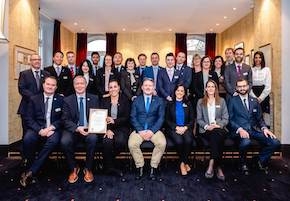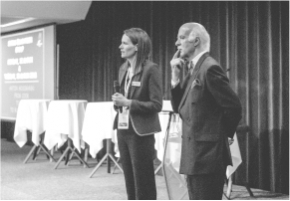- About
- Programs
- Innovation & Research
- Campus Life
- Career Services
- Admissions
- News & Events
- Alumni
How to Create a Positive Company Culture
Build a thriving workplace—learn how to create a positive company culture with actionable steps. Start transforming your team today.
Key Takeaways
- A positive company culture creates a workplace where individuals feel valued, supported, and connected to a shared purpose.
- It drives engagement, retention, innovation, and overall performance.
- The building blocks of a positive company culture include psychological safety, inclusion, recognition, and consistent leadership behavior.
- Organizations create a positive company culture by setting shared goals, reinforcing values through daily actions, and regularly measuring progress over time.
When asked about his many failed attempts at inventing the lightbulb, Thomas Edison reportedly said, "I have not failed. I've just found 10,000 ways that won't work." In the workplace, this mindset reflects what positive leadership and company culture look like: where setbacks are viewed as learning opportunities and people feel secure enough to experiment and grow.
Knowing how to create a positive company culture involves building an environment where people can do meaningful work, feel a sense of belonging, and grow through the way challenges are approached and resolved.
Why Positive Company Culture Matters More Than Ever
Company culture shows up in the little things: how meetings start and end, how ideas are received, how people are recognized, and how responsibility is shared. In many ways, these factors determine whether a workplace is stimulating or draining.
This matters now more than ever, as, according to Gallup’s 2024 State of the Global Workplace report, only 21% of employees are engaged at work, a decline from 23% the previous year. That two-point decline may seem small, but Gallup estimates it cost the global economy $438 billion in lost productivity in 2024 alone.
Gallup also found that employees who feel connected to their organization's culture are 4.3 times more likely to be engaged at work. In other words, culture directly influences their performance and even retention.
Your Leadership Journey Starts Here
Master the art of hospitality management
This connection becomes even more important when we look at one of the youngest segments of the workforce. A 2024 study by UKG revealed that 83% of Gen Z frontline workers feel burned out, with over one-third saying the burnout is so severe they're considering quitting.
Unlike past generations, Gen Z is not quietly pushing through these conditions. They're setting boundaries and openly rejecting toxic workplaces. According to the same UKG study, 71% would leave a job if it negatively affected their well-being, and 29% would reject a raise or promotion if it meant losing vacation time.
Most importantly, this is not just talk. This generation is acting. Gen Z is calling for genuine, values-based change, as evidenced by union drives at large corporations like Amazon and Starbucks and growing calls for mental health assistance.
What they're asking for isn't unreasonable: fair workloads, mental health support, flexible work options, and cultures that prioritize well-being over appearances. Yet many companies still respond with superficial fixes, such as wellness webinars, "fun" perks, or empty promises, while deeper cultural issues remain unaddressed.
Companies can no longer treat culture as something optional or secondary. The data, especially among Gen Z, indicates that culture directly influences business outcomes. Therefore, companies need to make real and lasting changes to how they build and maintain their culture.
The Building Blocks of a Strong Company Culture
Like any lasting structure, a strong company culture depends on a solid foundation and carefully placed components that support and reinforce one another. The stronger and more consistent these building blocks are, the more resilient and supportive the culture becomes.
1. Clear mission, vision, and values
A company's core mission, vision, and values aren't meant to sit in a PDF that no one reads. When they are manifested in day-to-day activities, they help set expectations in daily decisions, direct hiring, impact the way feedback is given, and shape career growth.
If transparency is one of the company’s values, leaders should demonstrate it in how they share information and respond to questions. If innovation is important, employees need room to test ideas without fearing negative consequences. What matters most is that values are visible in real behavior and are not just written declarations.
Companies can strengthen this connection by incorporating values into onboarding, applying them in team planning, referencing them during decision-making, and including them in how success is measured. Values have power when they are present in how people work, communicate, solve problems, and collaborate with others.
2. Trust and psychological safety
In many cases, psychological safety—rather than skill, experience, or even work ethic—is what truly distinguishes high-performing teams from those that barely scrape by. One of the most widely cited studies on this matter comes from Google’s Project Aristotle. The research team set out to understand why some teams thrive while others struggle, analyzing over 180 groups across the company.
Their most important finding was that teams performed best when members felt safe to speak openly, ask questions, share ideas, or admit mistakes without fearing embarrassment or negative consequences. This feeling of safety promotes open communication and better teamwork, which are vital to a healthy workplace culture.
Leaders have the most influence on trust and psychological safety. They can model it by displaying emotional intelligence, admitting mistakes, asking questions they don't have answers to, explicitly inviting input from everyone, following through on feedback, and treating all contributions with respect regardless of role or seniority.
3. Recognition and appreciation
From an early age, people respond to recognition. Being acknowledged and appreciated tends to strengthen their sense of worth and motivates ongoing effort. That is why employee recognition also plays a role in building a positive company culture.
Gallup research shows that when employees feel genuinely appreciated, they are more engaged, more productive, and less likely to leave. Yet only one in three U.S. workers says they actually received recognition in the past week.
To make recognition part of the everyday culture, peer-to-peer platforms can be particularly useful. These systems allow appreciation to flow across departments and roles rather than depending entirely on managers or leaders. However, systems alone aren't enough. Culture is shaped by daily interactions—whether that means thanking a colleague for their help, acknowledging quiet contributions, following up after a difficult week, or recognizing steady effort that might otherwise go unnoticed.
4. Inclusion and belonging
When people feel comfortable being themselves at work, they're more likely to contribute ideas, speak honestly, build meaningful relationships, stay engaged over time, and take initiative.
According to Gartner, by the end of 2022, 75% of organizations with frontline decision-making teams that reflected a diverse and inclusive culture exceeded their financial targets. Gender-diverse and inclusive teams also outperformed more homogenous teams by an average of 50%.
This kind of inclusivity is created by everyday choices, such as switching up who speaks first in meetings, ensuring that no one is left out of team activities, avoiding exclusive social circles that exclude others, or reaching out to someone who hasn't been as vocal.
However, inclusion must go beyond hiring goals or demographic checkboxes. It's about creating a workplace culture where individuals feel seen, respected, valued, and involved in meaningful ways. It's the difference between fitting in and truly belonging, between showing up and being missed if you're not there.
This belief is lived out fully at César Ritz Colleges, where inclusion shapes every part of student and staff life. With over 50 nationalities on campus and a commitment to diversity in learning styles, lived experience, leadership potential, and individual goals, César Ritz Colleges creates a culture of genuine belonging. The school's values guarantee space and build connections so every student feels supported, welcomed, and part of something greater.
Implementation Strategy: From Vision to Daily Practice
Creating a positive company culture is just as important in small businesses as it is in global enterprises, in office-based teams and remote ones. Effective leadership relies on culture as a core part of how work gets done. However, you cannot change culture overnight. You must build it through consistent action.
To transform the vision into daily practice, it's important to go through the following phases:
Phase 1: Assess your current culture
You can't improve what you haven't examined. Before making changes, take a clear look at the culture that already exists. A culture audit reveals how employees feel about their workplace, not just how management wants it to feel.
Use tools like pulse surveys, one-on-one interviews, anonymous feedback forms, and focus groups to uncover patterns, concerns, communication gaps, and hidden strengths within your organization.
It's also important that you don't overlook contradictions. Even if 70% of people say they feel "valued," and only 30% say their work goes unnoticed, there's still a significant gap that you should address.
Phase 2: Co-create culture goals
Once you have insights into how your culture is actually experienced across the organization, don't move straight into top-down planning. Instead, involve employees from different roles, functions, and levels in shaping the goals. This builds ownership, uncovers blind spots, and increases the likelihood of follow-through.
Use OKRs (Objectives and Key Results) or quarterly benchmarks to keep goals specific and measurable. For example:
- "Increase cross-department peer recognition by 40% in Q2."
- "Improve the inclusion sentiment score by 0.5 points by the end of the year."
Each goal should be tied to a business outcome, such as customer loyalty or employee retention. Connecting culture work to measurable drivers guarantees it's taken seriously and treated as a core part of strategy rather than an isolated initiative.
Phase 3: Roll out and reinforce
Most importantly, in order to create lasting change, culture needs to move from words into habits. That means embedding it into how people communicate, lead, make decisions, support one another, and work together each day.
Clear communication is important, but repetition and consistency are what make culture stick. One announcement isn't enough. Reinforce culture goals across multiple touchpoints, for example, through Slack updates, manager briefings, team huddles, onboarding materials, and regular newsletters. Make the message visible, accessible, and easy to connect with daily work.
Creating Culture in Different Work Environments
Work no longer means gathering in the same room or sitting at the same desk. As roles shift toward hybrid or remote setups, the absence of shared physical space makes it harder—but even more important—to maintain a strong, connected culture.
Each setup brings its own challenges, and building culture now means being intentional, adaptable, and clear about what connects everyone, no matter where they are.
Remote teams
The shift to remote work is no longer temporary. According to the State of Remote Work Report 2025 by We Work Remotely, nearly 60% of employers now identify as "Team Remote," citing major cost savings and strong satisfaction rates. Startups, small businesses, and companies in expensive metro areas are leading the way.
However, building culture in a virtual environment requires intentional effort. Without informal office moments—like hallway chats or impromptu coffee breaks—leaders must create new pathways for connection. Therefore, to strengthen culture in digital-first teams, leaders should:
- Use transparency tools like shared dashboards and open project notes
- Create regular rituals such as "Win Wednesday" shoutouts or "Gratitude Monday" prompts
- Build social space with optional watercooler events like book clubs or trivia nights
Hybrid workplaces
Hybrid sits in the middle—and getting it right requires a blend of the energy of in-person collaboration with remote flexibility. According to the same report by We Work Remotely, 25 % of employees reported updates to their remote or hybrid policies, and adoption of structured hybrid models rose from 20 % in 2023 to 37 % in 2025.
For hybrid workplaces, to reinforce culture rather than fragment it, leaders should:
- Make in-office days intentional, prioritizing collaboration and recognition
- Ensure equal recognition, rewarding all outcomes, whether in person or online
- Clarify communication practices so no one feels left out of key decisions
In-person teams
In co-located teams, culture is often experienced more viscerally. The tone of voice, hallway energy, and shared physical space all contribute to how people feel.
A well-designed in-person culture uses its environment as an advantage but doesn't rely on it as a shortcut. Some practices that can support this include:
- Design shared spaces to spark conversation
- Build onboarding around real experiences and not just policies or presentations
- Empower employees to lead cultural moments across departments and roles
- Use rituals, like welcome breakfasts or team wins boards, to make culture tangible
How to Measure and Maintain a Positive Culture
Culture often hides beneath surface-level engagement scores. A team might be meeting all deadlines and attending meetings, but that doesn't always mean people feel connected or motivated.
In order to determine whether your efforts are truly having an impact, monitor both quantitative and qualitative indicators, such as:
- eNPS (Employee Net Promoter Score)
- Voluntary turnover rate
- Culture pulse surveys
- Psychological safety or internal trust scores
Platforms like CultureAmp or Officevibe can help you collect such data, analyze patterns, and break down the results by role, region, or tenure. For example, a new initiative might resonate with recent hires but feel off-putting to staff who have been with the organization for longer. Segmenting the data helps you spot those differences and respond accordingly.
Most importantly, measurement shouldn't be a one-time audit. Culture is a living system, so the way you assess it needs to evolve alongside it.
Common Pitfalls to Avoid
We've already established that building culture takes time and countless small moments that add up. But just as it's built gradually, culture can also unravel in the same way, not necessarily with one big mistake but through a series of small missteps.
One of the easiest ways this happens is by leaning too hard on perks. Free snacks and fun outings might seem like signs of a great workplace, but they can't compensate for deeper issues. When clarity is missing, or trust feels thin, no amount of surface-level fun can fix it. Perks only add real value when they support what already works underneath.
Another pitfall is inconsistent leadership that says one thing and rewards another. Promoting balance while rewarding overwork or encouraging openness while reacting defensively creates silent tension. Over time, that gap between words and actions drains trust and makes values feel performative.
Feedback is another area where many organizations fall short. Asking for input but never following up makes people feel unheard. If survey results disappear into silence or lead to no visible change, people disengage. The simple act of closing the loop by responding and explaining what will or won't change, as well as why, can go a long way toward building trust.
Small Daily Actions, Long-Term Impact
To become a leader, you need more than vision and strategy. You need the ability to connect with different types of people, to recognize the behaviors that unify rather than divide, and to adapt your leadership style while still anchoring everyone to shared values. Culture gives people something to hold onto, and a good leader knows how to make it visible in action, not just in slogans.
At César Ritz Colleges, the Master of Science in Leadership program equips students with the insight, leadership qualities, cultural awareness, and practical tools to lead across industries and team structures. With us, you'll develop the mindset and methods to lead change and support teams so that everyone is working toward something that matters.
Frequently Asked Questions
How long does it take to change a company’s culture?
Changing company culture can take anywhere from several months to a few years, depending on the size of the organization as well as the depth of change required.
What are examples of toxic company culture?
Examples include lack of trust, poor communication, favoritism, fear-based management, and punishing honest feedback.
Are you wondering where to start your dream hospitality career? Look no further than a bachelor’s degree at César Ritz Colleges Switzerland.





















